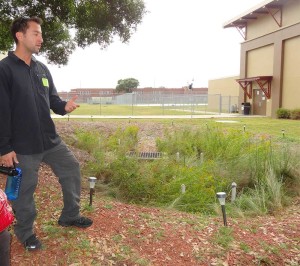Top photo: A restored drainage pond has become the center of its neighborhood – for people and for wildlife. Below: Ryan Locicero demonstrates how the rain garden at Young Middle School works. Photos Victoria Parsons
What do water quality and community building have in common?
In East Tampa, an older and economically disadvantaged community, a series of projects are focused on creating healthy sustainable neighborhoods using stormwater as the teaching tool.
A rain garden has sprouted in a neighborhood school, and a stormwater pond that neighbors once called an eyesore has become a popular meeting place with exercise trails and even a gazebo where several weddings have been performed. A smaller rain garden is planned for a community center where students can test water quality before and after it enters the system, and then develop similar small-scale gardens on at least two other sites.
“Kids now understand the hydrological cycle and their role in preventing water pollution,” notes Sarina Ergas, professor of civil and environmental engineering at the University of South Florida.
The understanding – and realization that neighborhoods play a critical role in water quality – is particularly important in East Tampa. Located north of McKay Bay just east of downtown Tampa, the 31 stormwater ponds in the community contribute a large percentage of contaminants to the bay’s most polluted segment.
The most recent initiative in the five-year-old project is funded through a grant from the National Fish and Wildlife Foundation and the Tampa Bay Estuary Program. It focuses on bio-retention projects that manage runoff and remove nutrients with natural – and naturally attractive – systems. Its multiple goals include:
- Reduce nitrogen loads from urban stormwater to Tampa Bay by 12% in 2025
- Increase the percentage of residents who are aware of the benefits of bio-retention from about three percent today to 25% in 2025
- Develop a workforce of engineers and technicians who are able to design, install, monitor and maintain bio-retention systems, including training for economically disadvantaged youth in East Tampa neighborhoods
- Document the efficacy of bio-retention systems in both laboratory settings and full-scale systems to encourage further use across the state.
 Traditional systems like stormwater ponds remove phosphorus but are less effective at removing nitrogen, the most important contaminant in Tampa Bay. Although bio-retention systems are a key component of the state’s focus on low-impact development, research documenting their efficacy in Florida’s unique ecosystem has been limited, Ergas said. Students in East Tampa will be designing, building and then testing new systems that include a water storage zone containing electron donors that support denitrification.
Traditional systems like stormwater ponds remove phosphorus but are less effective at removing nitrogen, the most important contaminant in Tampa Bay. Although bio-retention systems are a key component of the state’s focus on low-impact development, research documenting their efficacy in Florida’s unique ecosystem has been limited, Ergas said. Students in East Tampa will be designing, building and then testing new systems that include a water storage zone containing electron donors that support denitrification.
USF students working in laboratory settings have shown that adding a layer of locally available mulch can increase nitrogen removal in bio-retention systems from less than 20% to nearly 90%, she reports.
Involving younger students in stormwater education begins with a rain garden in the courtyard of Young Middle School, where flooding has long been an issue. “It gave us the opportunity to beautify the courtyard, at the same time we gave kids a place to play and teach them about water quality,” Ergas notes. Students helped design and build the system, and collect ongoing data as part of a curriculum that can be used as a prototype by teachers in other middle schools.
Three separate cells within the rain garden use different materials to test their impact on nutrients with students conducting water quality tests on the runoff as it enters the pond and again using monitoring wells at the far end of the system, explains Ryan Locicero, who is working toward a PhD that combines environmental engineering with education. Students also are documenting which plants survive, which dominate, and which can be harvested to beautify other areas.
A stormwater pond across the street from the school also functions as a living laboratory where students are involved in collecting data on the pond’s health, including water quality, vegetation and community use.
Teen participants in the Youth Leadership Movement also are involved in stormwater improvements, including new rain barrels planned for the community center’s rain garden, with the long-term goal of training for “green” jobs.
“What we’re really doing is helping students develop critical thinking skills so they can make informed decisions and become productive citizens in their community,” Locicero said. “We’re using stormwater as the educational tool to make that happen.”
This is part of a series of stories called “Elephant Bites,” that looks at innovative designs local governments and developers are using to capture nutrients before they enter surface waters. Learn more here.

